University Marketing Management Assessment on Starbucks
VerifiedAdded on 2022/01/20
|20
|4809
|29
Report
AI Summary
This report provides a comprehensive marketing analysis of Starbucks, evaluating its current strategies and market position. The analysis begins with an introduction to Starbucks, followed by an examination of its external marketing environment using Porter's Five Forces, assessing competitive rivalry, buyer and supplier power, and the threat of substitution and new entrants. A critical analysis of Starbucks' current marketing strategy identifies key issues, including integration challenges, market demand forecasting problems, inadequate investment in technology and research, low profitability, and poor responses to economic downturns. The report then proposes an innovative marketing plan for Starbucks, outlining marketing objectives such as a strong brand statement, an attractive brand loyalty program, and research on Consumer Lifecycle Value (CLV). The plan also suggests innovative pricing and product strategies, market positioning, and target market identification, including detailed market segmentation and a communication marketing mix. This encompasses public relations, advertising, sales promotion, and direct marketing, as well as suitable communication channels. The report concludes with an evaluation of the proposed marketing strategy, including customer feedback, sales growth, and social media reach, offering a forward-looking perspective on Starbucks' marketing potential.
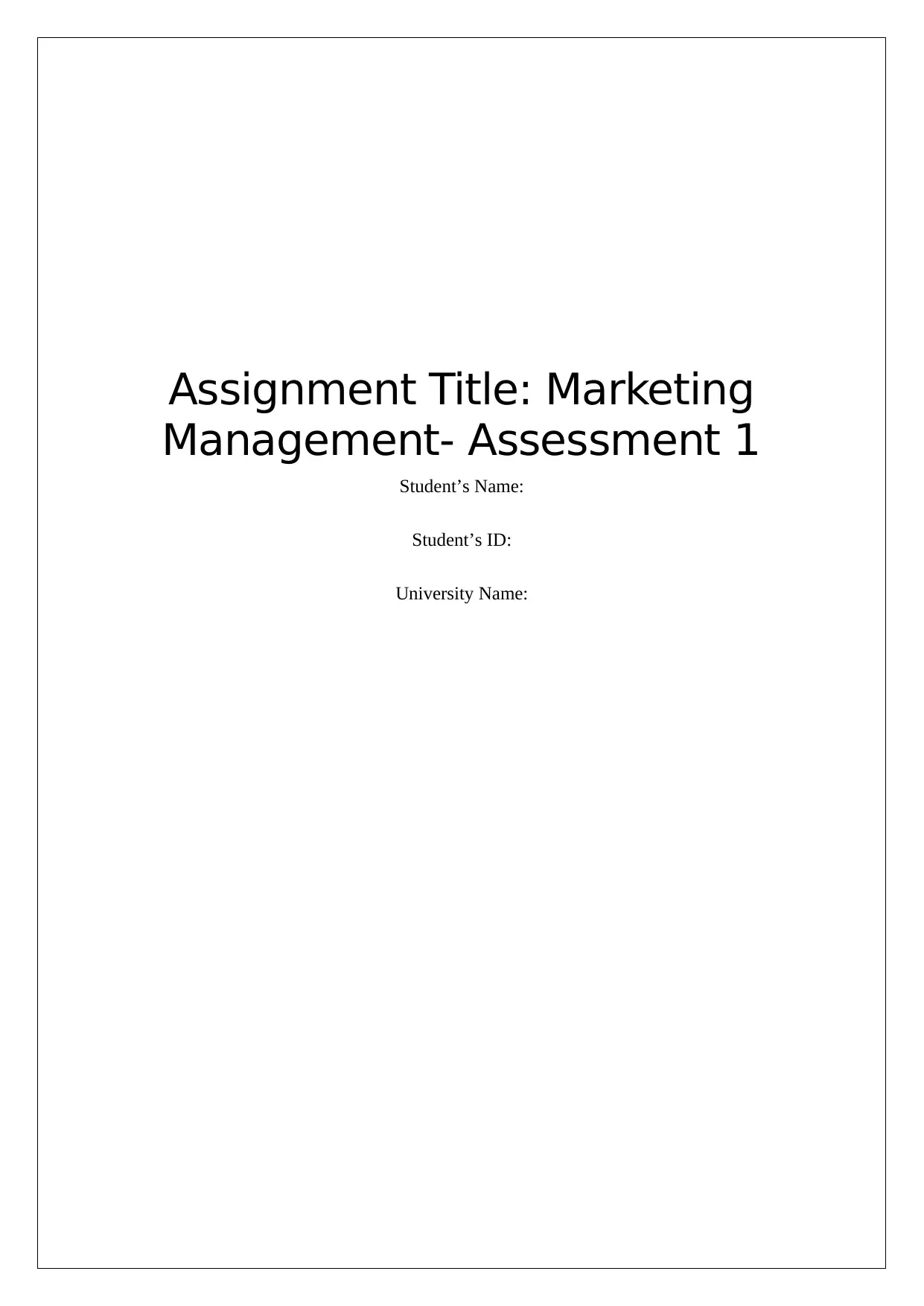
Assignment Title: Marketing
Management- Assessment 1
Student’s Name:
Student’s ID:
University Name:
Management- Assessment 1
Student’s Name:
Student’s ID:
University Name:
Paraphrase This Document
Need a fresh take? Get an instant paraphrase of this document with our AI Paraphraser
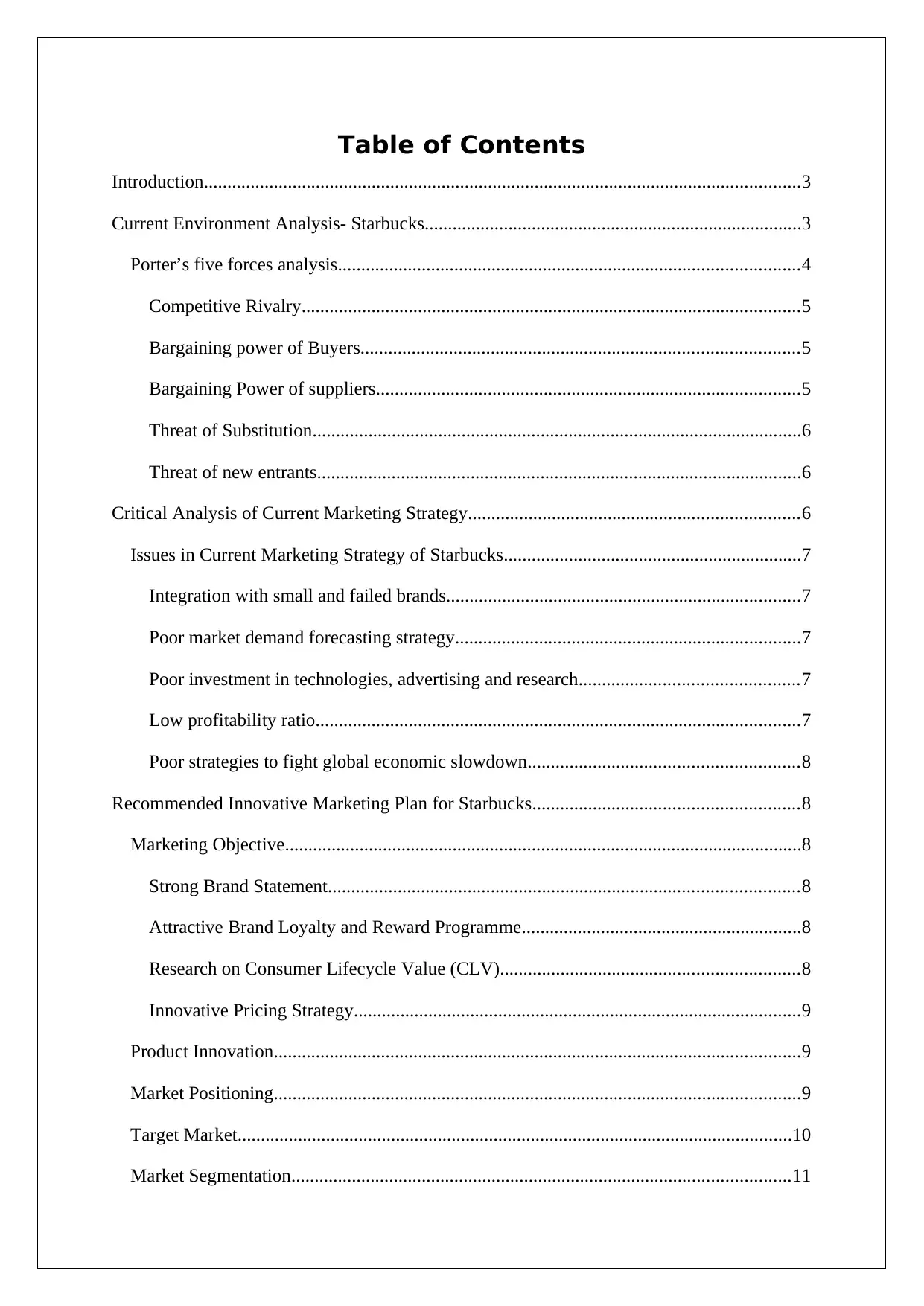
Table of Contents
Introduction................................................................................................................................3
Current Environment Analysis- Starbucks.................................................................................3
Porter’s five forces analysis...................................................................................................4
Competitive Rivalry...........................................................................................................5
Bargaining power of Buyers..............................................................................................5
Bargaining Power of suppliers...........................................................................................5
Threat of Substitution.........................................................................................................6
Threat of new entrants........................................................................................................6
Critical Analysis of Current Marketing Strategy.......................................................................6
Issues in Current Marketing Strategy of Starbucks................................................................7
Integration with small and failed brands............................................................................7
Poor market demand forecasting strategy..........................................................................7
Poor investment in technologies, advertising and research...............................................7
Low profitability ratio........................................................................................................7
Poor strategies to fight global economic slowdown..........................................................8
Recommended Innovative Marketing Plan for Starbucks.........................................................8
Marketing Objective...............................................................................................................8
Strong Brand Statement.....................................................................................................8
Attractive Brand Loyalty and Reward Programme............................................................8
Research on Consumer Lifecycle Value (CLV)................................................................8
Innovative Pricing Strategy................................................................................................9
Product Innovation.................................................................................................................9
Market Positioning.................................................................................................................9
Target Market.......................................................................................................................10
Market Segmentation...........................................................................................................11
Introduction................................................................................................................................3
Current Environment Analysis- Starbucks.................................................................................3
Porter’s five forces analysis...................................................................................................4
Competitive Rivalry...........................................................................................................5
Bargaining power of Buyers..............................................................................................5
Bargaining Power of suppliers...........................................................................................5
Threat of Substitution.........................................................................................................6
Threat of new entrants........................................................................................................6
Critical Analysis of Current Marketing Strategy.......................................................................6
Issues in Current Marketing Strategy of Starbucks................................................................7
Integration with small and failed brands............................................................................7
Poor market demand forecasting strategy..........................................................................7
Poor investment in technologies, advertising and research...............................................7
Low profitability ratio........................................................................................................7
Poor strategies to fight global economic slowdown..........................................................8
Recommended Innovative Marketing Plan for Starbucks.........................................................8
Marketing Objective...............................................................................................................8
Strong Brand Statement.....................................................................................................8
Attractive Brand Loyalty and Reward Programme............................................................8
Research on Consumer Lifecycle Value (CLV)................................................................8
Innovative Pricing Strategy................................................................................................9
Product Innovation.................................................................................................................9
Market Positioning.................................................................................................................9
Target Market.......................................................................................................................10
Market Segmentation...........................................................................................................11

Communication Marketing Mix...........................................................................................11
Public Relations and Publicity.........................................................................................11
Advertising.......................................................................................................................12
Sales Promotion...............................................................................................................12
Direct Marketing..............................................................................................................12
Suitable Communication Channels......................................................................................12
Promotion and marketing in conventional communication channel................................12
Promotion through Modern Communication Channels...................................................13
Evaluation of Marketing Strategy........................................................................................15
Customer Feedback..........................................................................................................15
Sales Growth....................................................................................................................15
Social Media Reach..........................................................................................................15
Conclusion................................................................................................................................15
Public Relations and Publicity.........................................................................................11
Advertising.......................................................................................................................12
Sales Promotion...............................................................................................................12
Direct Marketing..............................................................................................................12
Suitable Communication Channels......................................................................................12
Promotion and marketing in conventional communication channel................................12
Promotion through Modern Communication Channels...................................................13
Evaluation of Marketing Strategy........................................................................................15
Customer Feedback..........................................................................................................15
Sales Growth....................................................................................................................15
Social Media Reach..........................................................................................................15
Conclusion................................................................................................................................15
⊘ This is a preview!⊘
Do you want full access?
Subscribe today to unlock all pages.

Trusted by 1+ million students worldwide
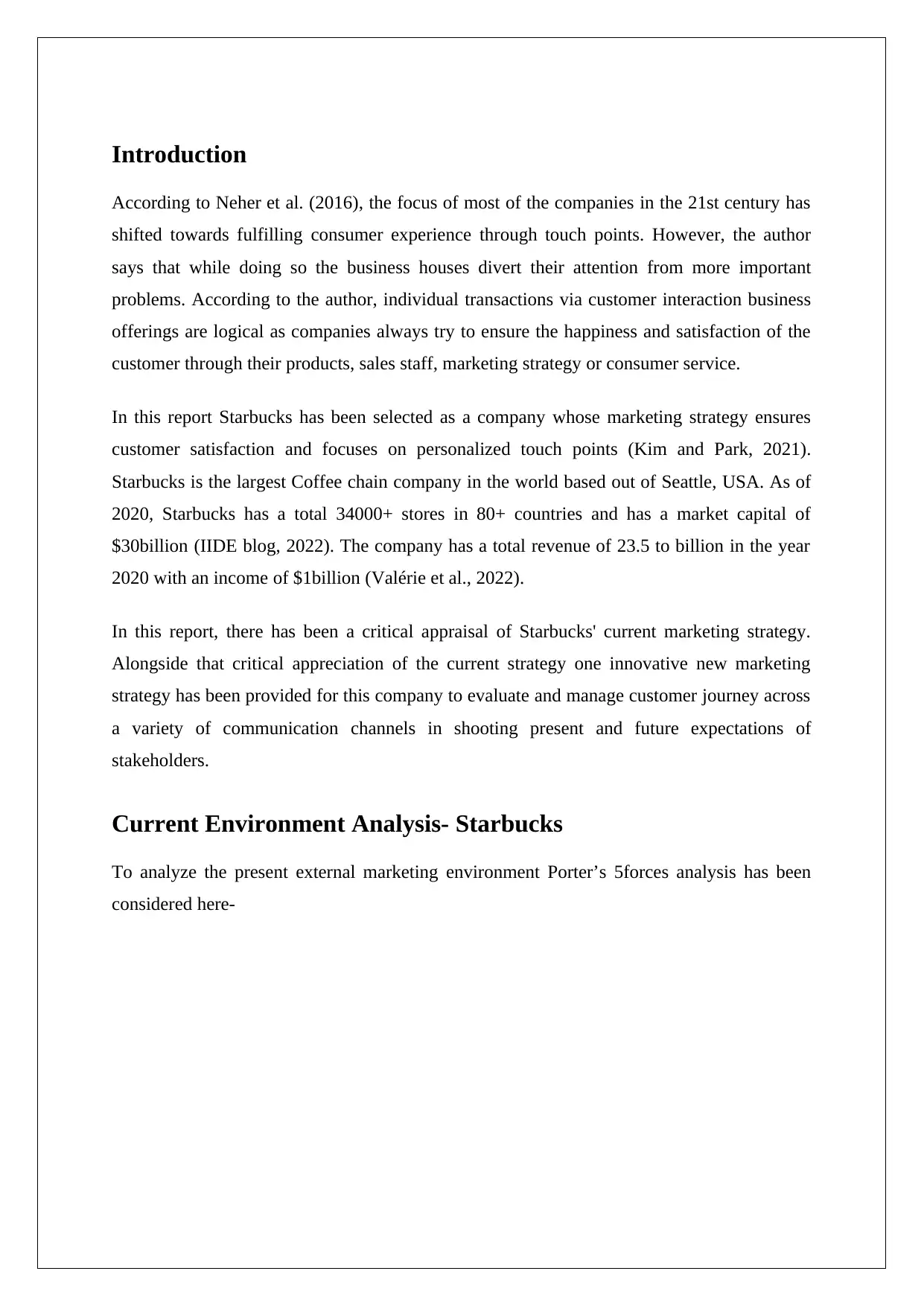
Introduction
According to Neher et al. (2016), the focus of most of the companies in the 21st century has
shifted towards fulfilling consumer experience through touch points. However, the author
says that while doing so the business houses divert their attention from more important
problems. According to the author, individual transactions via customer interaction business
offerings are logical as companies always try to ensure the happiness and satisfaction of the
customer through their products, sales staff, marketing strategy or consumer service.
In this report Starbucks has been selected as a company whose marketing strategy ensures
customer satisfaction and focuses on personalized touch points (Kim and Park, 2021).
Starbucks is the largest Coffee chain company in the world based out of Seattle, USA. As of
2020, Starbucks has a total 34000+ stores in 80+ countries and has a market capital of
$30billion (IIDE blog, 2022). The company has a total revenue of 23.5 to billion in the year
2020 with an income of $1billion (Valérie et al., 2022).
In this report, there has been a critical appraisal of Starbucks' current marketing strategy.
Alongside that critical appreciation of the current strategy one innovative new marketing
strategy has been provided for this company to evaluate and manage customer journey across
a variety of communication channels in shooting present and future expectations of
stakeholders.
Current Environment Analysis- Starbucks
To analyze the present external marketing environment Porter’s 5forces analysis has been
considered here-
According to Neher et al. (2016), the focus of most of the companies in the 21st century has
shifted towards fulfilling consumer experience through touch points. However, the author
says that while doing so the business houses divert their attention from more important
problems. According to the author, individual transactions via customer interaction business
offerings are logical as companies always try to ensure the happiness and satisfaction of the
customer through their products, sales staff, marketing strategy or consumer service.
In this report Starbucks has been selected as a company whose marketing strategy ensures
customer satisfaction and focuses on personalized touch points (Kim and Park, 2021).
Starbucks is the largest Coffee chain company in the world based out of Seattle, USA. As of
2020, Starbucks has a total 34000+ stores in 80+ countries and has a market capital of
$30billion (IIDE blog, 2022). The company has a total revenue of 23.5 to billion in the year
2020 with an income of $1billion (Valérie et al., 2022).
In this report, there has been a critical appraisal of Starbucks' current marketing strategy.
Alongside that critical appreciation of the current strategy one innovative new marketing
strategy has been provided for this company to evaluate and manage customer journey across
a variety of communication channels in shooting present and future expectations of
stakeholders.
Current Environment Analysis- Starbucks
To analyze the present external marketing environment Porter’s 5forces analysis has been
considered here-
Paraphrase This Document
Need a fresh take? Get an instant paraphrase of this document with our AI Paraphraser
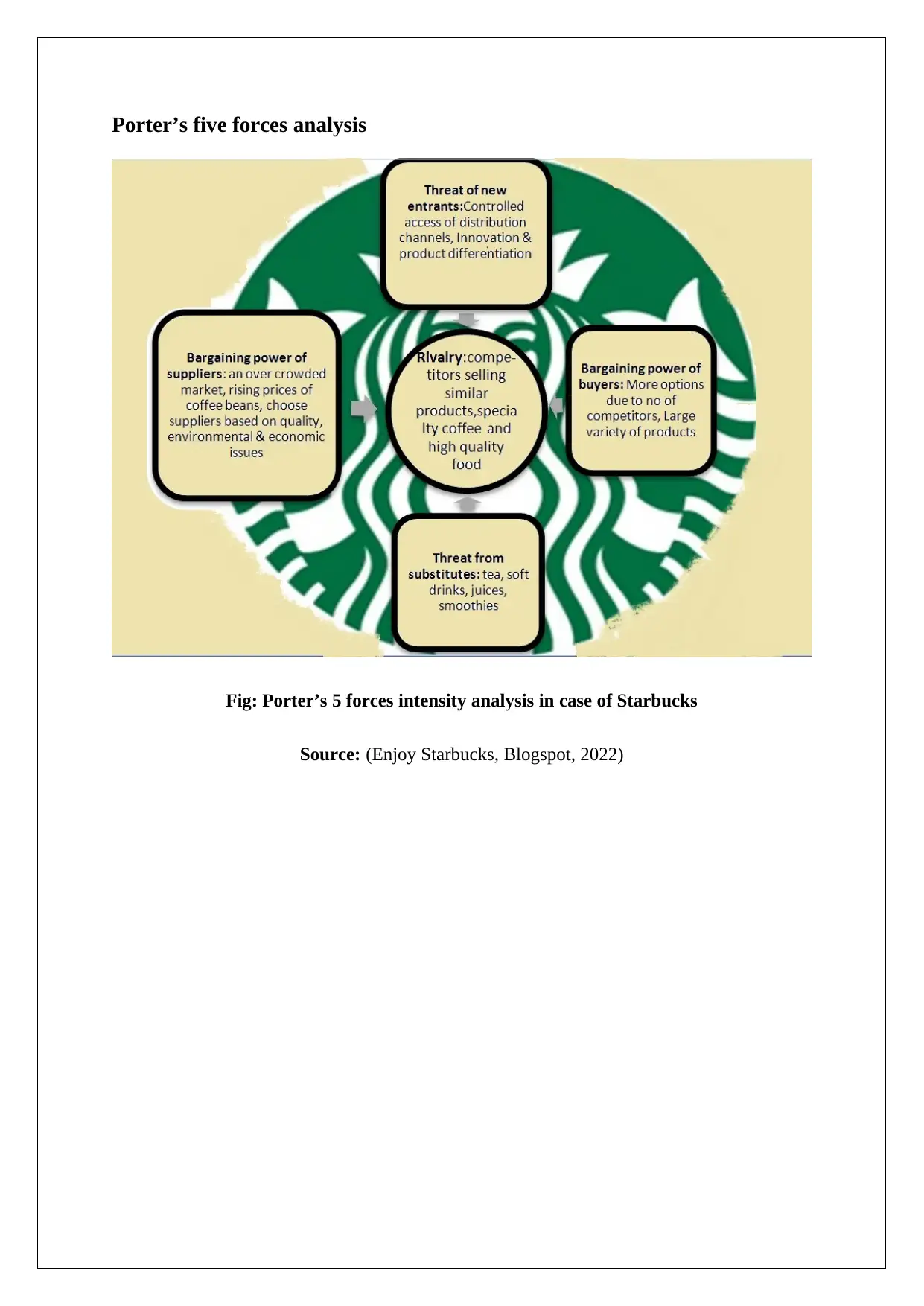
Porter’s five forces analysis
Fig: Porter’s 5 forces intensity analysis in case of Starbucks
Source: (Enjoy Starbucks, Blogspot, 2022)
Fig: Porter’s 5 forces intensity analysis in case of Starbucks
Source: (Enjoy Starbucks, Blogspot, 2022)

Competitive
Rivalry
Starbucks faces the threat of strong competition in the market in coffee
house and food service industries (Fern Fort University, 2022). There
are a large number of firms dealing in coffee and intensifying the
competition in the market. There are different sizes of competitors in
the market starting from small to moderate to big business houses with
different strategy and speciality (IIDE blog, 2022). In addition to the
rising competition in the market the switching cost is very low for
consumers (Porter Analysis, 2022). Most of the consumers are
switching to other coffee brands who are providing coffee at cheaper
prices.
Bargaining power
of Buyers
Low switching cost for consumers poses a grave threat to Starbucks
(LinkedIn, 2022). The strong force coming from the strong bargaining
power of consumers influences individual customer groups in the
international business environment (Fern Fort University, 2022). There
are a number of substitutes available in the market. Customers can
easily shift from Starbucks to other branches where beverages are
served through vending machines at cheaper prices (IIDE blog, 2022).
Therefore, bargaining power of the purchaser poses threat to the
company's revenue. However, the small size of individual purchases
poses a weak threat to the business.
Bargaining Power
of suppliers
The power of suppliers bargaining for the cost of coffee seeds is a
weak force to the company (Pratap, 2022). Because there are multiple
suppliers in the market and these suppliers are available in high variety.
The coffee market has one of the highest overall supplies which poses
a weak threat to any coffee business house. Massive number of
suppliers have various strategies and competency strategies against
each other with the objective of gaining profit from the market
supplying exclusive coffee materials (Hutt, 2018). Suppliers fight over
lowering the pricing strategy and making it much cost effective for
business houses. Hence, the bargaining power of suppliers becomes
Rivalry
Starbucks faces the threat of strong competition in the market in coffee
house and food service industries (Fern Fort University, 2022). There
are a large number of firms dealing in coffee and intensifying the
competition in the market. There are different sizes of competitors in
the market starting from small to moderate to big business houses with
different strategy and speciality (IIDE blog, 2022). In addition to the
rising competition in the market the switching cost is very low for
consumers (Porter Analysis, 2022). Most of the consumers are
switching to other coffee brands who are providing coffee at cheaper
prices.
Bargaining power
of Buyers
Low switching cost for consumers poses a grave threat to Starbucks
(LinkedIn, 2022). The strong force coming from the strong bargaining
power of consumers influences individual customer groups in the
international business environment (Fern Fort University, 2022). There
are a number of substitutes available in the market. Customers can
easily shift from Starbucks to other branches where beverages are
served through vending machines at cheaper prices (IIDE blog, 2022).
Therefore, bargaining power of the purchaser poses threat to the
company's revenue. However, the small size of individual purchases
poses a weak threat to the business.
Bargaining Power
of suppliers
The power of suppliers bargaining for the cost of coffee seeds is a
weak force to the company (Pratap, 2022). Because there are multiple
suppliers in the market and these suppliers are available in high variety.
The coffee market has one of the highest overall supplies which poses
a weak threat to any coffee business house. Massive number of
suppliers have various strategies and competency strategies against
each other with the objective of gaining profit from the market
supplying exclusive coffee materials (Hutt, 2018). Suppliers fight over
lowering the pricing strategy and making it much cost effective for
business houses. Hence, the bargaining power of suppliers becomes
⊘ This is a preview!⊘
Do you want full access?
Subscribe today to unlock all pages.

Trusted by 1+ million students worldwide
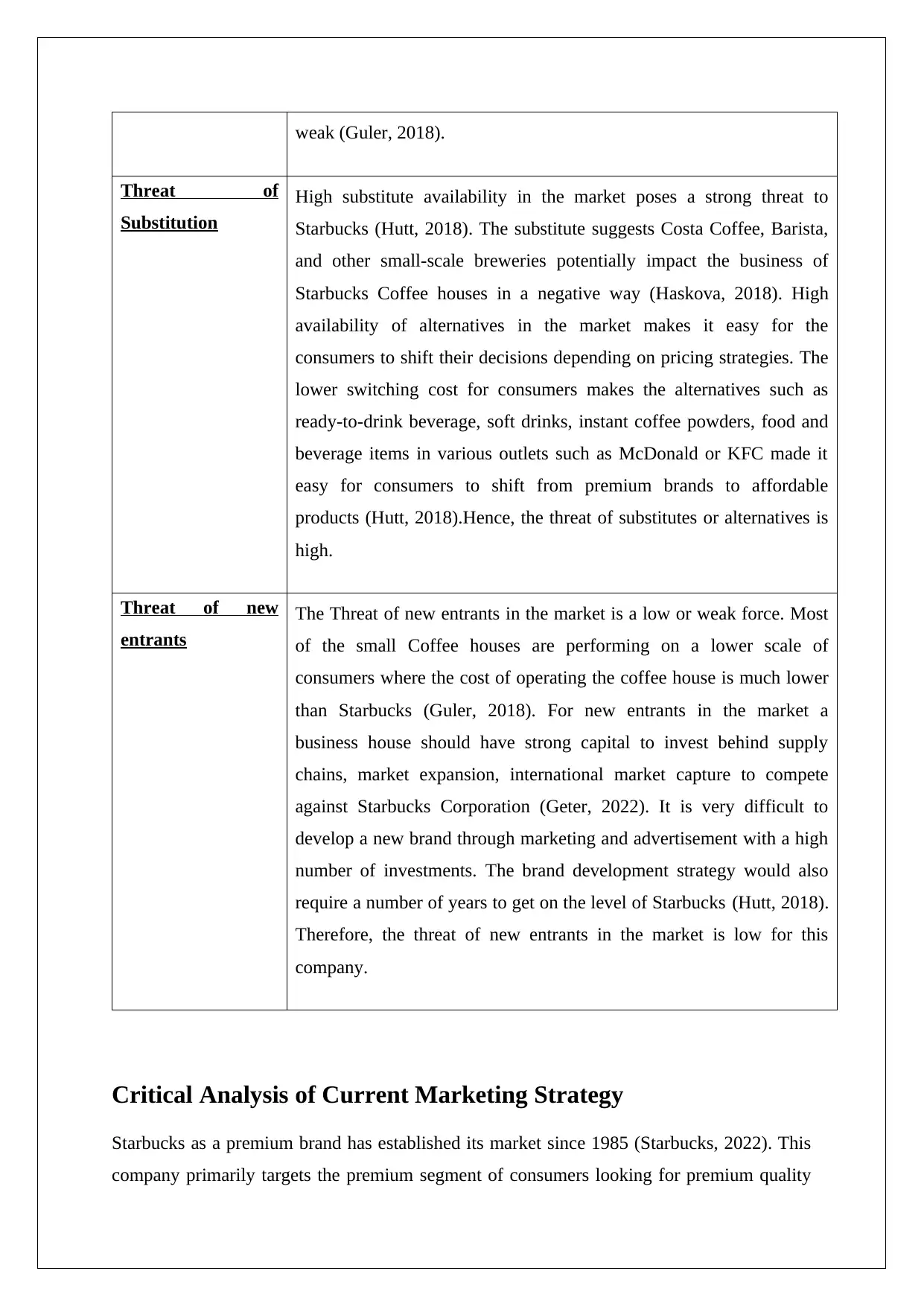
weak (Guler, 2018).
Threat of
Substitution
High substitute availability in the market poses a strong threat to
Starbucks (Hutt, 2018). The substitute suggests Costa Coffee, Barista,
and other small-scale breweries potentially impact the business of
Starbucks Coffee houses in a negative way (Haskova, 2018). High
availability of alternatives in the market makes it easy for the
consumers to shift their decisions depending on pricing strategies. The
lower switching cost for consumers makes the alternatives such as
ready-to-drink beverage, soft drinks, instant coffee powders, food and
beverage items in various outlets such as McDonald or KFC made it
easy for consumers to shift from premium brands to affordable
products (Hutt, 2018).Hence, the threat of substitutes or alternatives is
high.
Threat of new
entrants
The Threat of new entrants in the market is a low or weak force. Most
of the small Coffee houses are performing on a lower scale of
consumers where the cost of operating the coffee house is much lower
than Starbucks (Guler, 2018). For new entrants in the market a
business house should have strong capital to invest behind supply
chains, market expansion, international market capture to compete
against Starbucks Corporation (Geter, 2022). It is very difficult to
develop a new brand through marketing and advertisement with a high
number of investments. The brand development strategy would also
require a number of years to get on the level of Starbucks (Hutt, 2018).
Therefore, the threat of new entrants in the market is low for this
company.
Critical Analysis of Current Marketing Strategy
Starbucks as a premium brand has established its market since 1985 (Starbucks, 2022). This
company primarily targets the premium segment of consumers looking for premium quality
Threat of
Substitution
High substitute availability in the market poses a strong threat to
Starbucks (Hutt, 2018). The substitute suggests Costa Coffee, Barista,
and other small-scale breweries potentially impact the business of
Starbucks Coffee houses in a negative way (Haskova, 2018). High
availability of alternatives in the market makes it easy for the
consumers to shift their decisions depending on pricing strategies. The
lower switching cost for consumers makes the alternatives such as
ready-to-drink beverage, soft drinks, instant coffee powders, food and
beverage items in various outlets such as McDonald or KFC made it
easy for consumers to shift from premium brands to affordable
products (Hutt, 2018).Hence, the threat of substitutes or alternatives is
high.
Threat of new
entrants
The Threat of new entrants in the market is a low or weak force. Most
of the small Coffee houses are performing on a lower scale of
consumers where the cost of operating the coffee house is much lower
than Starbucks (Guler, 2018). For new entrants in the market a
business house should have strong capital to invest behind supply
chains, market expansion, international market capture to compete
against Starbucks Corporation (Geter, 2022). It is very difficult to
develop a new brand through marketing and advertisement with a high
number of investments. The brand development strategy would also
require a number of years to get on the level of Starbucks (Hutt, 2018).
Therefore, the threat of new entrants in the market is low for this
company.
Critical Analysis of Current Marketing Strategy
Starbucks as a premium brand has established its market since 1985 (Starbucks, 2022). This
company primarily targets the premium segment of consumers looking for premium quality
Paraphrase This Document
Need a fresh take? Get an instant paraphrase of this document with our AI Paraphraser

and exclusive taste of coffee. Starbucks is a company which has a growing market in
developing countries. In addition, with coffee and roasting services the company has
diversified its business towards food and other drinks as well as merchandise such as coffee
mugs, scoops, coffee presses and tumblers. The company is focusing towards aggressive
expansion franchise through a fair-trading policy (Harvard Scholar, 2022). However, the
company faces certain issues in current marketing strategy as a multinational brand dealing
with premium quality products and marketing channels.
Issues in Current Marketing Strategy of Starbucks
Integration with small and failed brands
Starbucks current marketing strategy has integrated some small coffee brands which has
failed in the market and have completely different work culture (Kim and Park, 2021). This
company has not been very successful in terms of merger and acquisition in the market as it
dealt with completely different work culture-based companies.
Poor market demand forecasting strategy
Starbucks has missed multiple opportunities in comparison with market competitors in
product demand and growth forecasting through market research and analysis. Because of
poor market research and not being very good at forecasting market requirements and
demands the company has ended up in keeping massive inventory both in channel and in-
house framework compared to its competitors (Joshmeah, 2022). Therefore, the company has
unnecessary loaded its inventory engaging lot of capital locked.
Poor investment in technologies, advertising and research
The company has poor investment in technologies and market research. Provided the
international expansion and its conduct in different demographic locations Starbucks is
required to invest more in technology to provide a global brand reach in the market (Guler,
2018). Currently the investment behind technical advantages is not in line with the
competitor’s technical advancement in the market and the vision of the company.
Low profitability ratio
Starbucks' net contribution and profitability ratio are also been in the industry average as the
company has not been able to tackle the challenge of rivals, small coffee brands and
developing countries. In addition, with coffee and roasting services the company has
diversified its business towards food and other drinks as well as merchandise such as coffee
mugs, scoops, coffee presses and tumblers. The company is focusing towards aggressive
expansion franchise through a fair-trading policy (Harvard Scholar, 2022). However, the
company faces certain issues in current marketing strategy as a multinational brand dealing
with premium quality products and marketing channels.
Issues in Current Marketing Strategy of Starbucks
Integration with small and failed brands
Starbucks current marketing strategy has integrated some small coffee brands which has
failed in the market and have completely different work culture (Kim and Park, 2021). This
company has not been very successful in terms of merger and acquisition in the market as it
dealt with completely different work culture-based companies.
Poor market demand forecasting strategy
Starbucks has missed multiple opportunities in comparison with market competitors in
product demand and growth forecasting through market research and analysis. Because of
poor market research and not being very good at forecasting market requirements and
demands the company has ended up in keeping massive inventory both in channel and in-
house framework compared to its competitors (Joshmeah, 2022). Therefore, the company has
unnecessary loaded its inventory engaging lot of capital locked.
Poor investment in technologies, advertising and research
The company has poor investment in technologies and market research. Provided the
international expansion and its conduct in different demographic locations Starbucks is
required to invest more in technology to provide a global brand reach in the market (Guler,
2018). Currently the investment behind technical advantages is not in line with the
competitor’s technical advancement in the market and the vision of the company.
Low profitability ratio
Starbucks' net contribution and profitability ratio are also been in the industry average as the
company has not been able to tackle the challenge of rivals, small coffee brands and
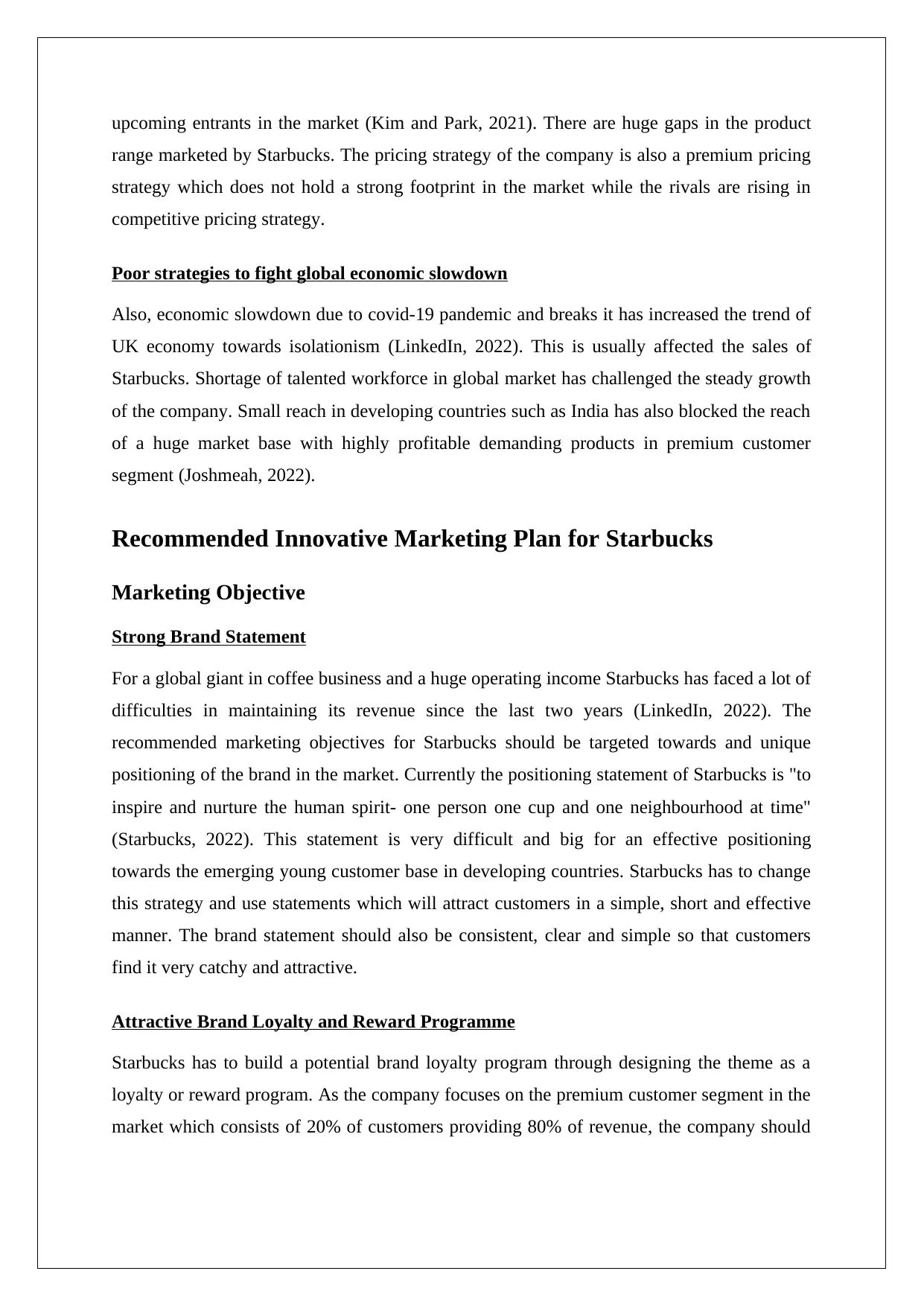
upcoming entrants in the market (Kim and Park, 2021). There are huge gaps in the product
range marketed by Starbucks. The pricing strategy of the company is also a premium pricing
strategy which does not hold a strong footprint in the market while the rivals are rising in
competitive pricing strategy.
Poor strategies to fight global economic slowdown
Also, economic slowdown due to covid-19 pandemic and breaks it has increased the trend of
UK economy towards isolationism (LinkedIn, 2022). This is usually affected the sales of
Starbucks. Shortage of talented workforce in global market has challenged the steady growth
of the company. Small reach in developing countries such as India has also blocked the reach
of a huge market base with highly profitable demanding products in premium customer
segment (Joshmeah, 2022).
Recommended Innovative Marketing Plan for Starbucks
Marketing Objective
Strong Brand Statement
For a global giant in coffee business and a huge operating income Starbucks has faced a lot of
difficulties in maintaining its revenue since the last two years (LinkedIn, 2022). The
recommended marketing objectives for Starbucks should be targeted towards and unique
positioning of the brand in the market. Currently the positioning statement of Starbucks is "to
inspire and nurture the human spirit- one person one cup and one neighbourhood at time"
(Starbucks, 2022). This statement is very difficult and big for an effective positioning
towards the emerging young customer base in developing countries. Starbucks has to change
this strategy and use statements which will attract customers in a simple, short and effective
manner. The brand statement should also be consistent, clear and simple so that customers
find it very catchy and attractive.
Attractive Brand Loyalty and Reward Programme
Starbucks has to build a potential brand loyalty program through designing the theme as a
loyalty or reward program. As the company focuses on the premium customer segment in the
market which consists of 20% of customers providing 80% of revenue, the company should
range marketed by Starbucks. The pricing strategy of the company is also a premium pricing
strategy which does not hold a strong footprint in the market while the rivals are rising in
competitive pricing strategy.
Poor strategies to fight global economic slowdown
Also, economic slowdown due to covid-19 pandemic and breaks it has increased the trend of
UK economy towards isolationism (LinkedIn, 2022). This is usually affected the sales of
Starbucks. Shortage of talented workforce in global market has challenged the steady growth
of the company. Small reach in developing countries such as India has also blocked the reach
of a huge market base with highly profitable demanding products in premium customer
segment (Joshmeah, 2022).
Recommended Innovative Marketing Plan for Starbucks
Marketing Objective
Strong Brand Statement
For a global giant in coffee business and a huge operating income Starbucks has faced a lot of
difficulties in maintaining its revenue since the last two years (LinkedIn, 2022). The
recommended marketing objectives for Starbucks should be targeted towards and unique
positioning of the brand in the market. Currently the positioning statement of Starbucks is "to
inspire and nurture the human spirit- one person one cup and one neighbourhood at time"
(Starbucks, 2022). This statement is very difficult and big for an effective positioning
towards the emerging young customer base in developing countries. Starbucks has to change
this strategy and use statements which will attract customers in a simple, short and effective
manner. The brand statement should also be consistent, clear and simple so that customers
find it very catchy and attractive.
Attractive Brand Loyalty and Reward Programme
Starbucks has to build a potential brand loyalty program through designing the theme as a
loyalty or reward program. As the company focuses on the premium customer segment in the
market which consists of 20% of customers providing 80% of revenue, the company should
⊘ This is a preview!⊘
Do you want full access?
Subscribe today to unlock all pages.

Trusted by 1+ million students worldwide
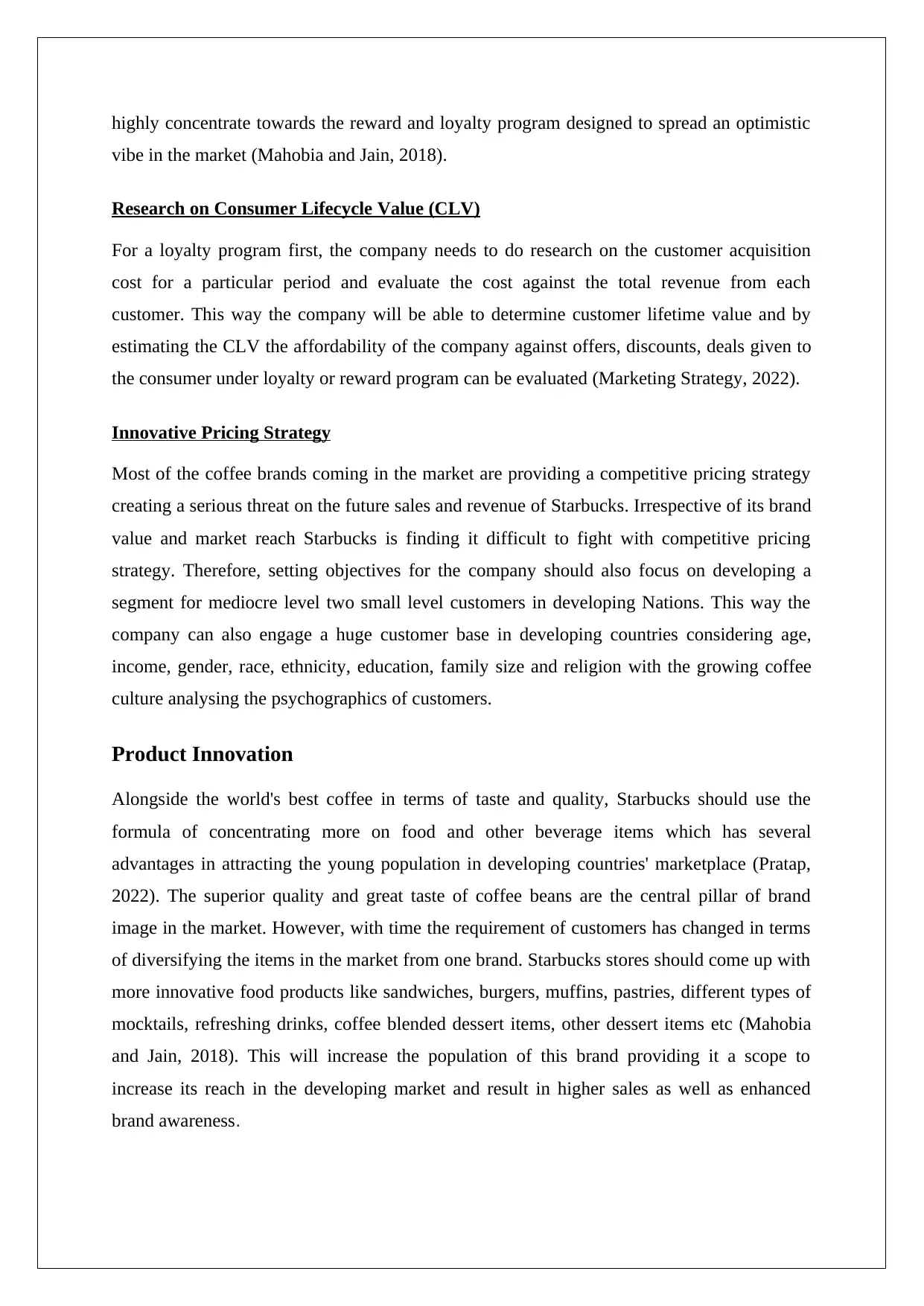
highly concentrate towards the reward and loyalty program designed to spread an optimistic
vibe in the market (Mahobia and Jain, 2018).
Research on Consumer Lifecycle Value (CLV)
For a loyalty program first, the company needs to do research on the customer acquisition
cost for a particular period and evaluate the cost against the total revenue from each
customer. This way the company will be able to determine customer lifetime value and by
estimating the CLV the affordability of the company against offers, discounts, deals given to
the consumer under loyalty or reward program can be evaluated (Marketing Strategy, 2022).
Innovative Pricing Strategy
Most of the coffee brands coming in the market are providing a competitive pricing strategy
creating a serious threat on the future sales and revenue of Starbucks. Irrespective of its brand
value and market reach Starbucks is finding it difficult to fight with competitive pricing
strategy. Therefore, setting objectives for the company should also focus on developing a
segment for mediocre level two small level customers in developing Nations. This way the
company can also engage a huge customer base in developing countries considering age,
income, gender, race, ethnicity, education, family size and religion with the growing coffee
culture analysing the psychographics of customers.
Product Innovation
Alongside the world's best coffee in terms of taste and quality, Starbucks should use the
formula of concentrating more on food and other beverage items which has several
advantages in attracting the young population in developing countries' marketplace (Pratap,
2022). The superior quality and great taste of coffee beans are the central pillar of brand
image in the market. However, with time the requirement of customers has changed in terms
of diversifying the items in the market from one brand. Starbucks stores should come up with
more innovative food products like sandwiches, burgers, muffins, pastries, different types of
mocktails, refreshing drinks, coffee blended dessert items, other dessert items etc (Mahobia
and Jain, 2018). This will increase the population of this brand providing it a scope to
increase its reach in the developing market and result in higher sales as well as enhanced
brand awareness.
vibe in the market (Mahobia and Jain, 2018).
Research on Consumer Lifecycle Value (CLV)
For a loyalty program first, the company needs to do research on the customer acquisition
cost for a particular period and evaluate the cost against the total revenue from each
customer. This way the company will be able to determine customer lifetime value and by
estimating the CLV the affordability of the company against offers, discounts, deals given to
the consumer under loyalty or reward program can be evaluated (Marketing Strategy, 2022).
Innovative Pricing Strategy
Most of the coffee brands coming in the market are providing a competitive pricing strategy
creating a serious threat on the future sales and revenue of Starbucks. Irrespective of its brand
value and market reach Starbucks is finding it difficult to fight with competitive pricing
strategy. Therefore, setting objectives for the company should also focus on developing a
segment for mediocre level two small level customers in developing Nations. This way the
company can also engage a huge customer base in developing countries considering age,
income, gender, race, ethnicity, education, family size and religion with the growing coffee
culture analysing the psychographics of customers.
Product Innovation
Alongside the world's best coffee in terms of taste and quality, Starbucks should use the
formula of concentrating more on food and other beverage items which has several
advantages in attracting the young population in developing countries' marketplace (Pratap,
2022). The superior quality and great taste of coffee beans are the central pillar of brand
image in the market. However, with time the requirement of customers has changed in terms
of diversifying the items in the market from one brand. Starbucks stores should come up with
more innovative food products like sandwiches, burgers, muffins, pastries, different types of
mocktails, refreshing drinks, coffee blended dessert items, other dessert items etc (Mahobia
and Jain, 2018). This will increase the population of this brand providing it a scope to
increase its reach in the developing market and result in higher sales as well as enhanced
brand awareness.
Paraphrase This Document
Need a fresh take? Get an instant paraphrase of this document with our AI Paraphraser
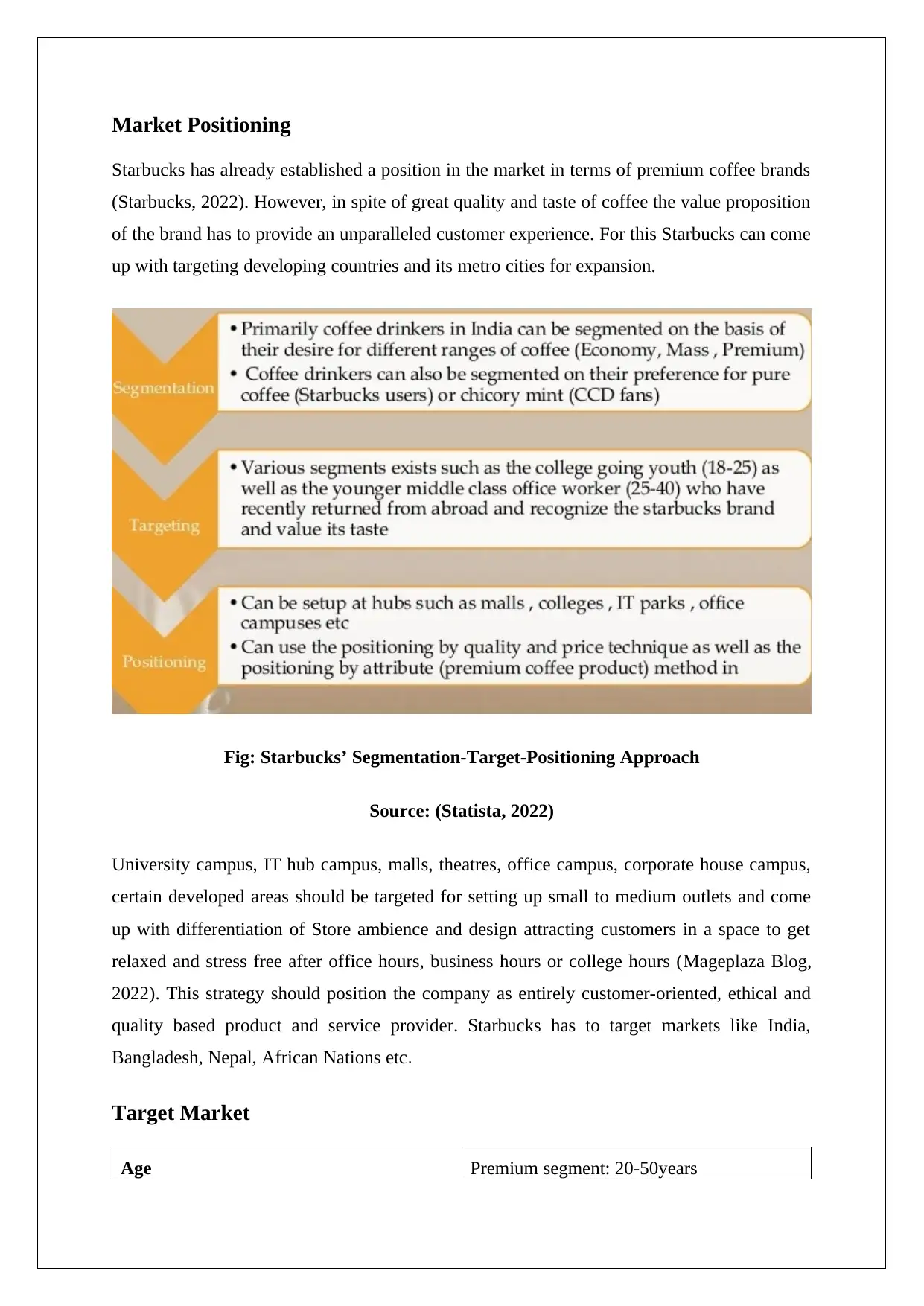
Market Positioning
Starbucks has already established a position in the market in terms of premium coffee brands
(Starbucks, 2022). However, in spite of great quality and taste of coffee the value proposition
of the brand has to provide an unparalleled customer experience. For this Starbucks can come
up with targeting developing countries and its metro cities for expansion.
Fig: Starbucks’ Segmentation-Target-Positioning Approach
Source: (Statista, 2022)
University campus, IT hub campus, malls, theatres, office campus, corporate house campus,
certain developed areas should be targeted for setting up small to medium outlets and come
up with differentiation of Store ambience and design attracting customers in a space to get
relaxed and stress free after office hours, business hours or college hours (Mageplaza Blog,
2022). This strategy should position the company as entirely customer-oriented, ethical and
quality based product and service provider. Starbucks has to target markets like India,
Bangladesh, Nepal, African Nations etc.
Target Market
Age Premium segment: 20-50years
Starbucks has already established a position in the market in terms of premium coffee brands
(Starbucks, 2022). However, in spite of great quality and taste of coffee the value proposition
of the brand has to provide an unparalleled customer experience. For this Starbucks can come
up with targeting developing countries and its metro cities for expansion.
Fig: Starbucks’ Segmentation-Target-Positioning Approach
Source: (Statista, 2022)
University campus, IT hub campus, malls, theatres, office campus, corporate house campus,
certain developed areas should be targeted for setting up small to medium outlets and come
up with differentiation of Store ambience and design attracting customers in a space to get
relaxed and stress free after office hours, business hours or college hours (Mageplaza Blog,
2022). This strategy should position the company as entirely customer-oriented, ethical and
quality based product and service provider. Starbucks has to target markets like India,
Bangladesh, Nepal, African Nations etc.
Target Market
Age Premium segment: 20-50years
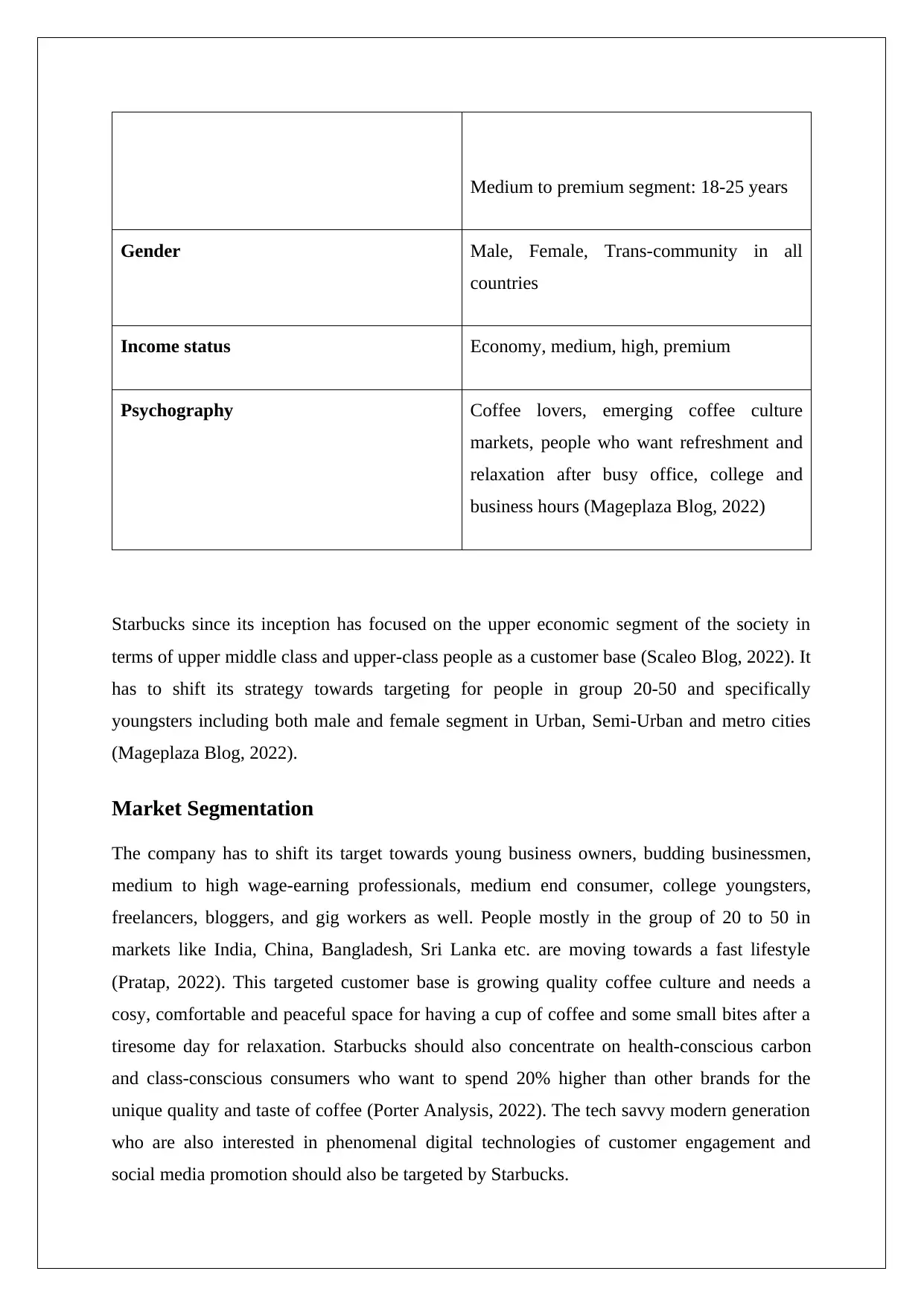
Medium to premium segment: 18-25 years
Gender Male, Female, Trans-community in all
countries
Income status Economy, medium, high, premium
Psychography Coffee lovers, emerging coffee culture
markets, people who want refreshment and
relaxation after busy office, college and
business hours (Mageplaza Blog, 2022)
Starbucks since its inception has focused on the upper economic segment of the society in
terms of upper middle class and upper-class people as a customer base (Scaleo Blog, 2022). It
has to shift its strategy towards targeting for people in group 20-50 and specifically
youngsters including both male and female segment in Urban, Semi-Urban and metro cities
(Mageplaza Blog, 2022).
Market Segmentation
The company has to shift its target towards young business owners, budding businessmen,
medium to high wage-earning professionals, medium end consumer, college youngsters,
freelancers, bloggers, and gig workers as well. People mostly in the group of 20 to 50 in
markets like India, China, Bangladesh, Sri Lanka etc. are moving towards a fast lifestyle
(Pratap, 2022). This targeted customer base is growing quality coffee culture and needs a
cosy, comfortable and peaceful space for having a cup of coffee and some small bites after a
tiresome day for relaxation. Starbucks should also concentrate on health-conscious carbon
and class-conscious consumers who want to spend 20% higher than other brands for the
unique quality and taste of coffee (Porter Analysis, 2022). The tech savvy modern generation
who are also interested in phenomenal digital technologies of customer engagement and
social media promotion should also be targeted by Starbucks.
Gender Male, Female, Trans-community in all
countries
Income status Economy, medium, high, premium
Psychography Coffee lovers, emerging coffee culture
markets, people who want refreshment and
relaxation after busy office, college and
business hours (Mageplaza Blog, 2022)
Starbucks since its inception has focused on the upper economic segment of the society in
terms of upper middle class and upper-class people as a customer base (Scaleo Blog, 2022). It
has to shift its strategy towards targeting for people in group 20-50 and specifically
youngsters including both male and female segment in Urban, Semi-Urban and metro cities
(Mageplaza Blog, 2022).
Market Segmentation
The company has to shift its target towards young business owners, budding businessmen,
medium to high wage-earning professionals, medium end consumer, college youngsters,
freelancers, bloggers, and gig workers as well. People mostly in the group of 20 to 50 in
markets like India, China, Bangladesh, Sri Lanka etc. are moving towards a fast lifestyle
(Pratap, 2022). This targeted customer base is growing quality coffee culture and needs a
cosy, comfortable and peaceful space for having a cup of coffee and some small bites after a
tiresome day for relaxation. Starbucks should also concentrate on health-conscious carbon
and class-conscious consumers who want to spend 20% higher than other brands for the
unique quality and taste of coffee (Porter Analysis, 2022). The tech savvy modern generation
who are also interested in phenomenal digital technologies of customer engagement and
social media promotion should also be targeted by Starbucks.
⊘ This is a preview!⊘
Do you want full access?
Subscribe today to unlock all pages.

Trusted by 1+ million students worldwide
1 out of 20
Related Documents
Your All-in-One AI-Powered Toolkit for Academic Success.
+13062052269
info@desklib.com
Available 24*7 on WhatsApp / Email
![[object Object]](/_next/static/media/star-bottom.7253800d.svg)
Unlock your academic potential
Copyright © 2020–2025 A2Z Services. All Rights Reserved. Developed and managed by ZUCOL.




